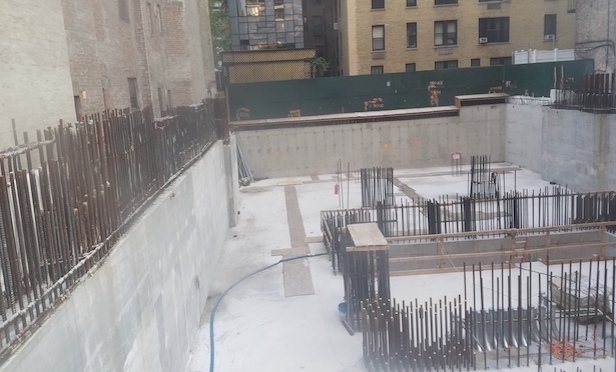
New York City—Representing the East River Fifties Alliance (ERFA), attorney Michael Hiller, will file a lawsuit against both the owner of Sutton 58 (through Sutton 58 Holding Company LLC) and the Board of Standards and Appeals.
Gamma Real Estate, headed by chair and CEO Richard Kalikow and his son, Jonathan Kalikow, the company's president, owns the property. The alliance is fighting their plans to build an 800-foot, luxury residential tower, called Sutton 58, at 428-432 E. 58th St.
Carlo Costanza, executive director of New York City's BSA, tells GlobeSt.com that last week the board voted to approve Gamma's statutory vesting application. The board found the application satisfied all requirements of §11-331 of the New York City Zoning Resolution. That section allows for construction under certain conditions. Thus, the BSA granted approval for the project to proceed.
Calling the project a “monstrous, out-of-place mega-tower,” Lisa Mercurio, ERFA's director of communications, says “the Board of Standards and Appeals abrogated its responsibilities under the Zoning Resolution, including especially its obligation to independently assess the invalidity of ill-gotten, after-hours work variances and alleged street closure permits that allowed the tower's developer to engage in a race to complete the foundation.”
However, John H. Banks, the Real Estate Board of New York president says, “The Board of Standards and Appeals made a sensible decision, recognizing the importance of as-of-right development to our city's continued growth and success. New York City needs predictability, continued investment and new housing, and the BSA's decision helps achieve that.”
Backstory
In 2015, Joseph Beninati of the Bauhouse Group had widely announced his plans to build a 1,000-foot tower at the location, then called 3 Sutton Place. Alarmed residents in response formed ERFA. By January 2016, the alliance submitted a rezoning proposal to limit super tall buildings in the neighborhood.
The Bauhouse Group defaulted on Gamma's $147 million loan for the 428-432 E. 58th St. property. After winning a foreclosure auction in December 2016, Gamma closed on the property in April 2017.
On November 30, 2017, due to efforts of ERFA, civic groups, city council member Ben Kallos, Manhattan borough president Gale Brewer, congresswoman Carol Maloney and others, the City Council passed the Sutton rezoning, 45-0. It applies to E. 51st to E. 59th streets, east of First Avenue. The rezoning requires 45% of a new development's floor area be below the height of 150 feet. This limits building heights to approximately 300 feet.
Basis for the Lawsuit Today
When Gamma was acquiring Sutton 58 from bankruptcy, it intended to perform as much work as possible under the old zoning, says Hiller. “The developer can't complain to be an innocent who got caught up in an unfortunate rezoning effort. This is a developer who engaged in a determined, dedicated course of conduct to violate the Zoning Resolution both in its letter and its spirit,” he asserts.

Hiller explains to properly file an application for development rights to vest under the prior zoning, the developer must prove four things, as threshold requirements:
(1) The work was done pursuant to validly and lawfully issued permits.
(2) The work done must be lawful.
(3) The developer must have completed all excavation work.
(4) Substantial work must be made on the foundation.
If all four requirement are met, the BSA may consider whether to allow the developer to benefit from the prior zoning.
On April 10, 2018, Kallos testified before the BSA to oppose Sutton 58's exemption from the rezoning. He acknowledged that vesting provisions exist to protect real estate owners from unforeseen zoning changes which unfairly restrict development after properties are acquired.
However, he says in this case the developers knew about the pending zoning restrictions. Thus, they accelerated the construction, “seeking to turn the vesting provisions of the Zoning Resolution upside down.”
In a May 9, 2018 submission to the BSA chair, Margery Perlmutter, Hiller contends that the developer “performed the lion's share of its foundation work” having obtained an after-hours variance permit through misrepresentation—alleging after-hours, weekend work was necessary to protect the public. The submission notes that JWE Engineers concluded that none of the work performed after Oct. 30, 2017 was necessary to protect the public. The letter emphasizes that the developer's race to complete the foundation while on notice of or in response to an impending zoning changes cannot constitute the basis for a vesting claim.
Hiller alleges that the developer failed to comply with the multiple stipulations in the Department of Transportation permits. These included signage and proper notice of street closures. In addition, the letter to the BSA chair describes how construction trucks and concrete mixers blocking the streets in effect created a street closure without having the appropriate permits. Hiller asserts that 73% of the concrete was poured with after-hour variances invalidly issued or in violation of DOT permit requirements. Thus, these concrete pourings should not be credited as substantial work on the foundation.
Gamma Realty did not respond to GlobeSt.com by the filing of this article. In December, the department of buildings issued a stop work order. Pursuant to the BSA's decision last week, the DOB can lift the order. After the BSA's decision is published, the ERFA will have 30 days to file its lawsuit. At the time it could file an application for a temporary restraining order and request a preliminary injunction to again halt construction.
© Touchpoint Markets, All Rights Reserved. Request academic re-use from www.copyright.com. All other uses, submit a request to [email protected]. For more inforrmation visit Asset & Logo Licensing.







